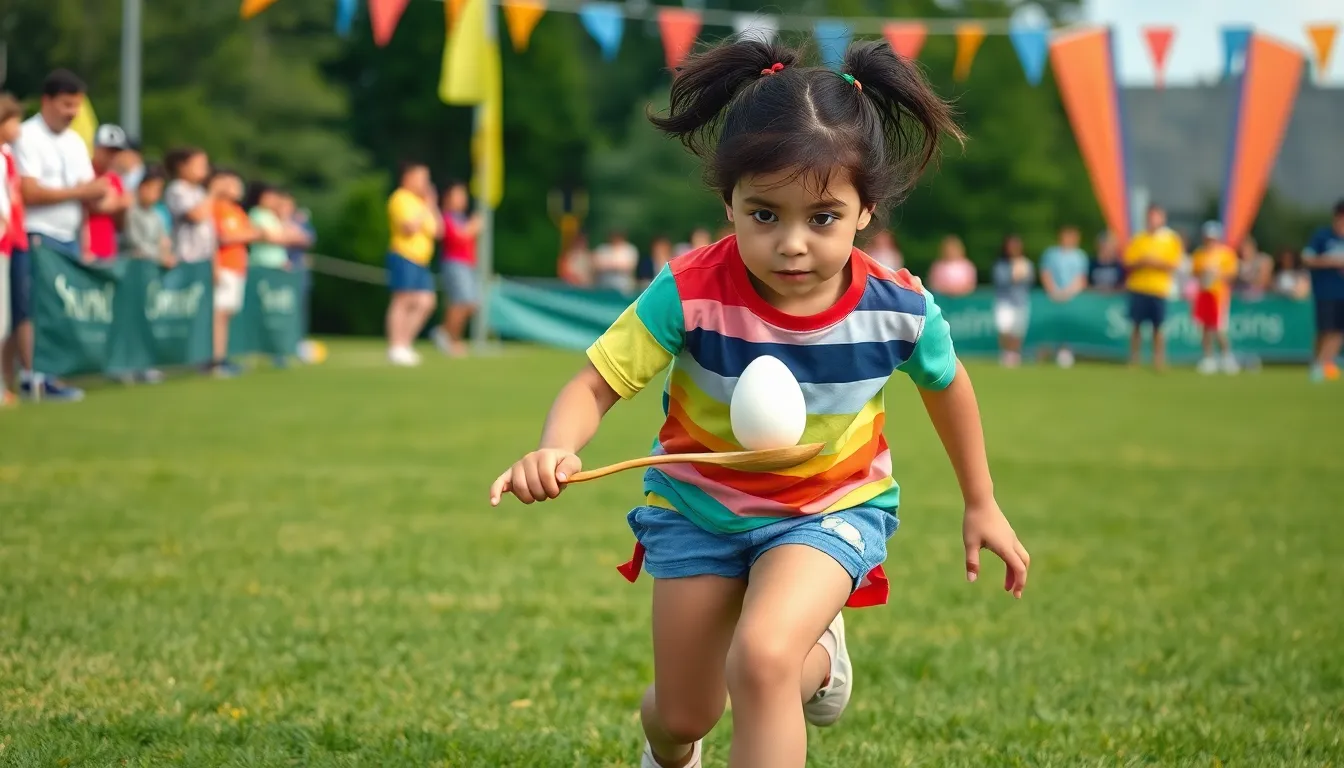Picture this: a sunny day, a crowd buzzing with excitement, and competitors teetering on the edge of chaos, balancing eggs on spoons. The egg and spoon race isn’t just a childhood pastime; it’s a test of balance, agility, and sheer determination. Who knew that a simple egg could turn a friendly competition into a hilarious spectacle?
Table of Contents
ToggleOverview Of The Egg And Spoon Race
The egg and spoon race features participants balancing eggs on spoons while navigating an obstacle course or a straight path. Held at various events, including school sports days and community gatherings, this race unites competitors in a test of skill. Balance and concentration play crucial roles in determining success.
Participants may use raw, hard-boiled, or plastic eggs, with each option offering unique challenges. Wooden or metal spoons typically serve as carrying tools, adding weight and difficulty. Teams and individual competitors can join, promoting teamwork and sportsmanship.
Race formats vary, allowing for different speeds and tactics. Some races focus solely on speed, while others may incorporate additional tasks, increasing complexity. Races can be timed, or they may feature elimination rounds for added excitement.
Victory hinges on maintaining steady hands and quick feet. Participants must demonstrate agility to avoid dropping their eggs. Various age groups often compete, ensuring inclusivity and enjoyment for all participants.
Prizes for the fastest or most creative competitors often enhance the competitive spirit. Recognition may come in forms like ribbons, medals, or prizes specific to the event. With practice, individuals can improve their skills, turning a simple game into a beloved tradition.
The egg and spoon race creates an atmosphere of fun and camaraderie. This event emphasizes physical activity and encourages friendly competition among participants. Its simplicity and tradition make it a cherished part of many communities.
History Of The Egg And Spoon Race
The egg and spoon race has origins tracing back to England, where it emerged as a traditional village game. It has evolved over time, becoming a staple at school sports days and various community events.
Origin And Evolution
Origins of the race can be related to historical English fairs and festivals. These gatherings included various competitions, featuring unique challenges. Over the years, the race gained traction due to its simplicity and accessibility. Children and adults alike participated, creating a joyful atmosphere. Engaging in this activity became a popular pastime, and adaptations emerged, including different egg types and spoon sizes. Evolution continued as organizations embraced the race incorporating it into larger sporting events.
Cultural Significance
Cultural significance of the egg and spoon race spans generations. It fosters community spirit during local gatherings and school events. Participants find joy in both competition and camaraderie, building strong relationships. Many view the race as a rite of passage for children, introducing them to the world of competitive sports. Celebrating unique traditions, communities adopt variations to reflect their values and history. The event encourages physical activity among all ages, reinforcing its role as a beloved tradition.
How To Play The Egg And Spoon Race
The egg and spoon race combines fun and competition, offering an engaging experience for participants. Success hinges on skillfully balancing an egg on a spoon while racing to the finish line.
Equipment Needed
Participants require simple equipment for the race. Spoons, typically wooden or plastic, hold the eggs securely. Hard-boiled eggs are commonly used, while plastic eggs serve as a mess-free alternative. Each egg offers unique challenges in terms of balance and stability. Additional items like cones or markers help define the racecourse, enhancing the competitive nature of the event. Participants need a clear space to run, allowing for safety and excitement.
Rules And Regulations
Specific rules guide the egg and spoon race, emphasizing fair play. Competitors must keep the egg on the spoon while completing the race, with penalties for dropping or losing the egg. Disqualification occurs if they run without balancing the egg. Races can adopt various formats, from individuals racing against time to teams collaborating to finish. Starting lines and finish lines typically define the course, helping organize participants. Winning criteria often include not just speed but also creativity in navigating obstacles.
Benefits Of The Egg And Spoon Race
The egg and spoon race offers various benefits that enhance physical fitness and social interaction.
Physical Benefits
Engaging in the egg and spoon race promotes physical fitness among participants. Balance and coordination improve as competitors focus on keeping eggs steady while running. Strength also gains from the repetitive motion of balancing and maneuvering. Cardiovascular endurance gets a boost through continuous movement during the race. Consistent participation in the race fosters a fun way to engage in exercise, making it an enjoyable alternative to traditional workouts.
Social Benefits
Interaction during the egg and spoon race builds camaraderie among participants. Teams often form, requiring cooperation and communication to achieve a common goal. Friendly competition enhances social skills as individuals cheer on their peers. Such events create opportunities for bonding, reinforcing friendships and fostering community spirit. Families and communities come together, emphasizing inclusivity and shared experiences, which strengthens social ties and cultural connections.
Variations Of The Egg And Spoon Race
Numerous fun variations of the egg and spoon race exist to enhance the standard game experience.
Competitive Formats
Competitive formats energize the race, offering participants a chance to showcase their skills. Relay races involve teams working together, with each member balancing an egg before passing it to the next. Time trials test individual speed, prompting racers to complete the course in the shortest time possible. Some formats include obstacles like cones or hurdles, which add complexity and excitement. Team battle formats encourage friendly rivalry, where two teams compete head-to-head, promoting teamwork and strategy. Each format retains the fundamental challenge of balancing the egg while encouraging creativity and planning.
Fun Variations For Kids
Children enjoy fun variations that make the egg and spoon race even more engaging. In the color challenge, kids use different colored eggs to match specific colored spoons. The themed races add flair, allowing children to dress up according to various themes, such as superheroes or animals. An added twist includes a blindfolded race, where kids rely on their sense of balance and communication skills to navigate the course. Incorporating teamwork elements, kids might race in pairs to encourage collaboration, creating a lively atmosphere and fostering friendships. These variations keep the event fresh, fun, and inclusive for children of all ages.
Conclusion
The egg and spoon race remains a timeless tradition that brings joy and excitement to participants of all ages. Its blend of skill and fun creates an engaging atmosphere where friendships flourish and community bonds strengthen. As families come together to cheer on competitors, the spirit of friendly competition shines through.
With various formats and creative twists, the race continues to evolve while maintaining its core values of teamwork and sportsmanship. Whether it’s a school event or a local gathering, the egg and spoon race serves as a reminder of the simple pleasures of childhood and the joy of shared experiences. Embracing this cherished activity fosters not just physical fitness but also lasting memories.









